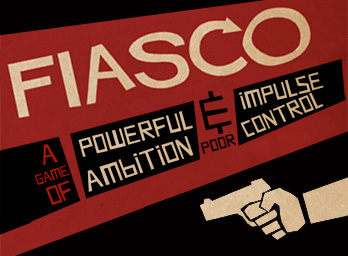What can be said about Fiasco that hasn’t been said before? Fiasco may be the most talked about tabletop roleplaying game that doesn’t require some form of game master. Players utilize a variety of rolls and tables to set highly improvisational scenes that usually culminate in a dramatically terrible finale. Fiasco is incredibly fun with the right group of players, and does a lot behind the scenes to encourage entertaining play. Something that I believe Fiasco does well, that many other tabletop games shy away from, is encouraging productive metagaming.
In many ways, Fiasco is not a role-playing game. Sure, players take on personas and play out scenes, but the true core of the game is storytelling. One way that I might justify this definition is the function of the die pool during the bulk of the game. Players award dice that can have positive or negative effects on the ultimate outcome of the characters. These dice are two different colors and are pulled from a limited pool. By awarding dice, players are communicating non-diegetically with the other players at the table. In most tabletop games, utilizing information outside the information known by your character is frowned upon. In Fiasco, this kind of metagaming feels crucial to the function of the game. Telling an interesting story requires bringing together the different story components, many of which won’t be available to the characters being played. For this reason, Fiasco ends up feeling very different from most other tabletop games.
Identifying the role of metagaming in Fiasco does little to attribute a judgment of quality to the game. However, I tend to view the metagame-heavy nature of Fiasco as one of its strongest features. For one, drawing a clear distinction between character and player can be unintuitive for people who are new to tabletop games. I find that new players frequently utilize information that their character shouldn’t know, especially if that information relates to the safety of their character. Many people come from a board/video game background; this usually translates into caring less about storytelling compared to concrete objectives. Fiasco’s rule system harnesses the tendency of these players to metagame while nudging them toward narrative construction. Fiasco’s dice system helps to communicate the fact that not all characters have a happy ending, and that telling a good story should come before personal goals or survival.
This isn’t to say that Fiasco is a perfect game. Many of the qualities that make Fiasco much more accessible than other games in the genre can be negative for more experienced players. The system of rolling on tables to construct the various settings, relationships, items, etc. is good for extremely rapid setup regardless of experience with the engine. This is undoubtedly a positive in most cases, but this could be seen as removing agency from players who want to tell more specific stories. It can also reduce the potential for replayability, assuming the players have played enough to exhaust the more interesting table options. Finally, (this is less of a critique and more of an observation) Fiasco games tend to encourage a very particular style of story. The stories created are usually over the top and generally devolve into low-brow comedy. If you don’t mind that, Fiasco will likely be a great game for you and your improv inclined friend group.
